University Finance Module: Capital Cost, Debt, and Investment Analysis
VerifiedAdded on 2022/08/13
|6
|1043
|20
Discussion Board Post
AI Summary
This assignment provides detailed answers to three discussion questions in financial economics. The first question explores the determinants of a company's cost of capital, differentiating between systematic and non-systematic risk, and examining the impact of leverage. The second question delves into the advantages and disadvantages of incorporating debt into a company's capital structure, considering optimal debt-to-equity ratios for different types of businesses. The final question addresses the evaluation of an investment project using NPV, IRR, and ARR, discussing the divisional manager's confidence in the project's viability and methods to enhance the reliability of the analysis. The assignment also includes a bibliography of relevant sources.

Financial Economics
Paraphrase This Document
Need a fresh take? Get an instant paraphrase of this document with our AI Paraphraser
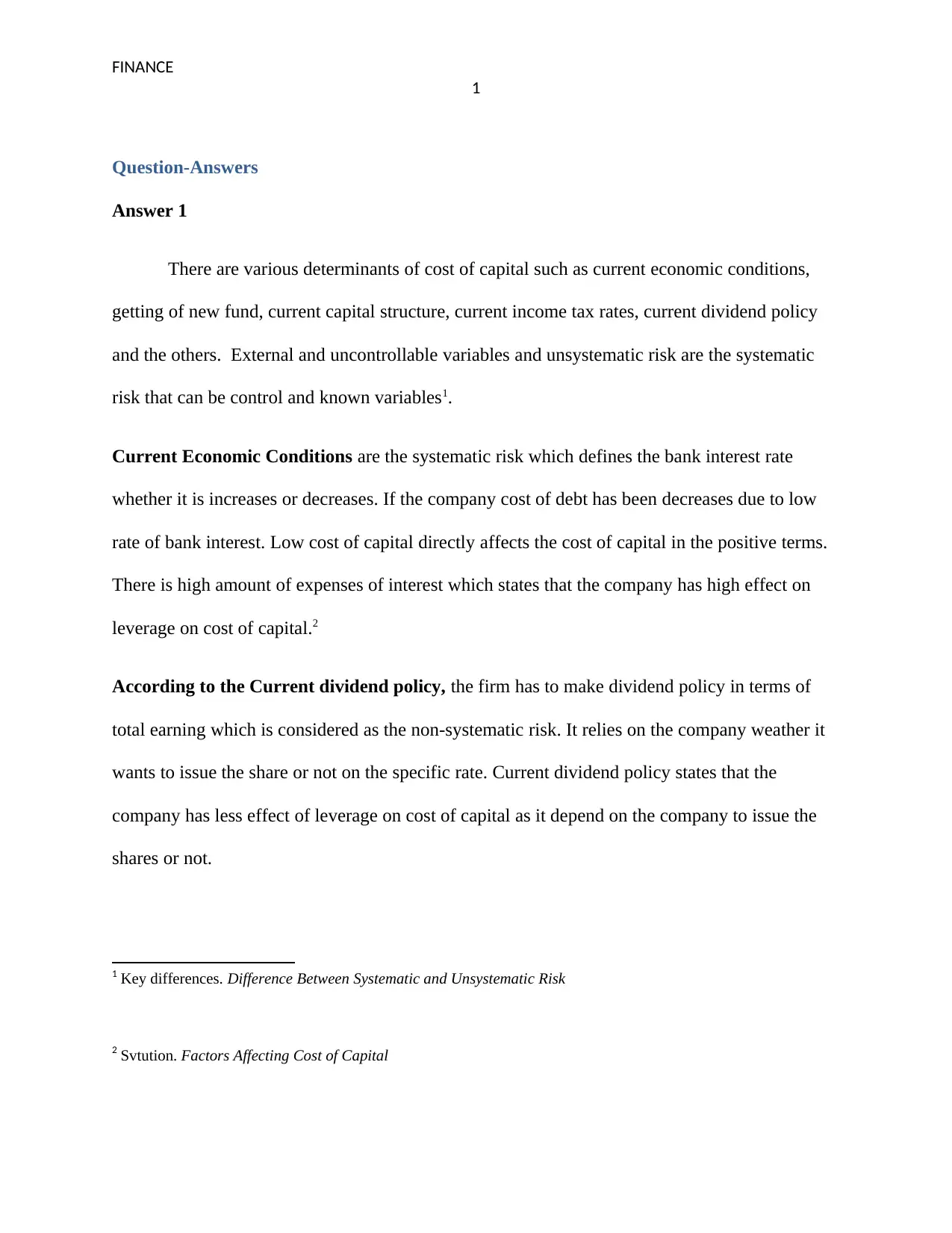
FINANCE
1
Question-Answers
Answer 1
There are various determinants of cost of capital such as current economic conditions,
getting of new fund, current capital structure, current income tax rates, current dividend policy
and the others. External and uncontrollable variables and unsystematic risk are the systematic
risk that can be control and known variables1.
Current Economic Conditions are the systematic risk which defines the bank interest rate
whether it is increases or decreases. If the company cost of debt has been decreases due to low
rate of bank interest. Low cost of capital directly affects the cost of capital in the positive terms.
There is high amount of expenses of interest which states that the company has high effect on
leverage on cost of capital.2
According to the Current dividend policy, the firm has to make dividend policy in terms of
total earning which is considered as the non-systematic risk. It relies on the company weather it
wants to issue the share or not on the specific rate. Current dividend policy states that the
company has less effect of leverage on cost of capital as it depend on the company to issue the
shares or not.
1 Key differences. Difference Between Systematic and Unsystematic Risk
2 Svtution. Factors Affecting Cost of Capital
1
Question-Answers
Answer 1
There are various determinants of cost of capital such as current economic conditions,
getting of new fund, current capital structure, current income tax rates, current dividend policy
and the others. External and uncontrollable variables and unsystematic risk are the systematic
risk that can be control and known variables1.
Current Economic Conditions are the systematic risk which defines the bank interest rate
whether it is increases or decreases. If the company cost of debt has been decreases due to low
rate of bank interest. Low cost of capital directly affects the cost of capital in the positive terms.
There is high amount of expenses of interest which states that the company has high effect on
leverage on cost of capital.2
According to the Current dividend policy, the firm has to make dividend policy in terms of
total earning which is considered as the non-systematic risk. It relies on the company weather it
wants to issue the share or not on the specific rate. Current dividend policy states that the
company has less effect of leverage on cost of capital as it depend on the company to issue the
shares or not.
1 Key differences. Difference Between Systematic and Unsystematic Risk
2 Svtution. Factors Affecting Cost of Capital
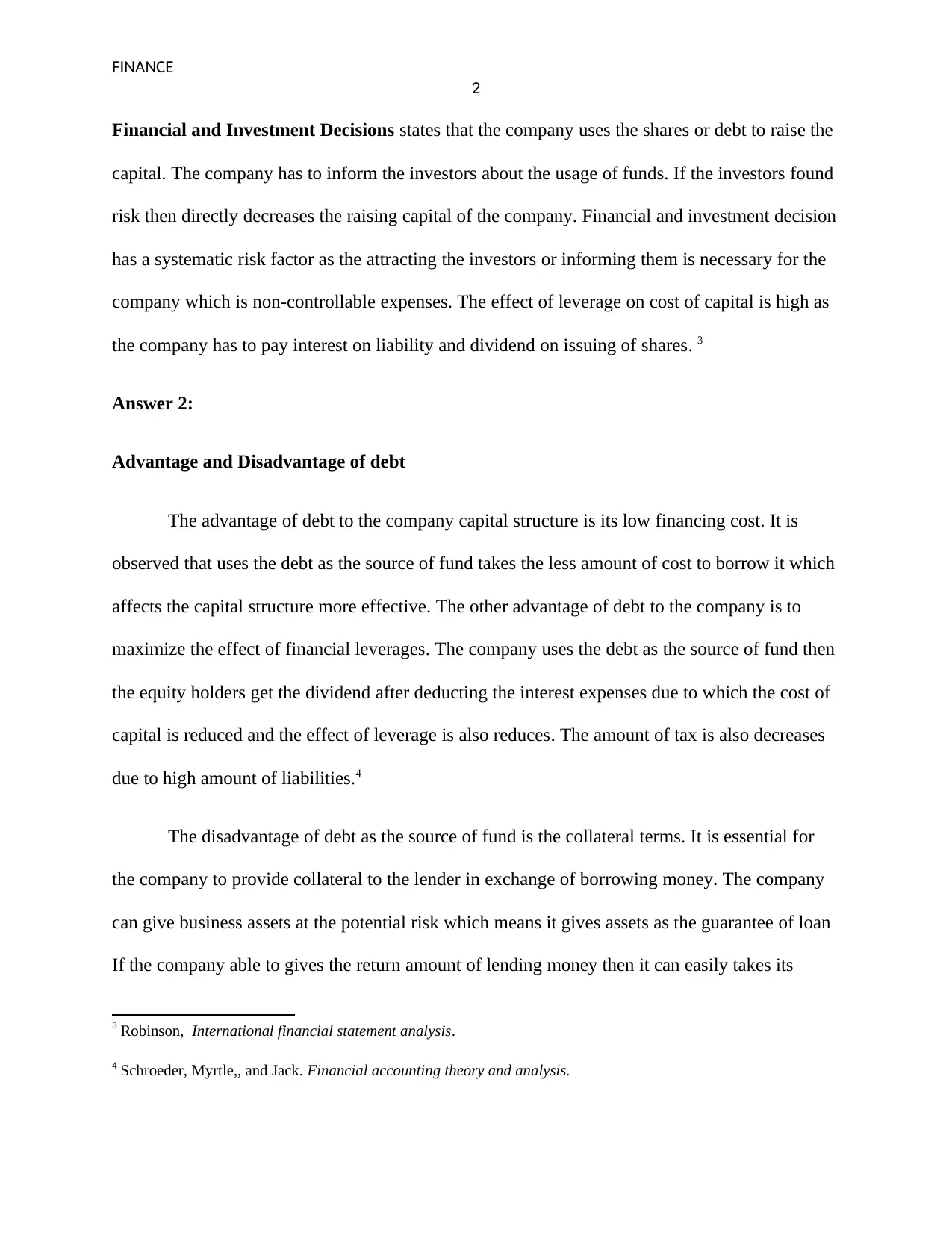
FINANCE
2
Financial and Investment Decisions states that the company uses the shares or debt to raise the
capital. The company has to inform the investors about the usage of funds. If the investors found
risk then directly decreases the raising capital of the company. Financial and investment decision
has a systematic risk factor as the attracting the investors or informing them is necessary for the
company which is non-controllable expenses. The effect of leverage on cost of capital is high as
the company has to pay interest on liability and dividend on issuing of shares. 3
Answer 2:
Advantage and Disadvantage of debt
The advantage of debt to the company capital structure is its low financing cost. It is
observed that uses the debt as the source of fund takes the less amount of cost to borrow it which
affects the capital structure more effective. The other advantage of debt to the company is to
maximize the effect of financial leverages. The company uses the debt as the source of fund then
the equity holders get the dividend after deducting the interest expenses due to which the cost of
capital is reduced and the effect of leverage is also reduces. The amount of tax is also decreases
due to high amount of liabilities.4
The disadvantage of debt as the source of fund is the collateral terms. It is essential for
the company to provide collateral to the lender in exchange of borrowing money. The company
can give business assets at the potential risk which means it gives assets as the guarantee of loan
If the company able to gives the return amount of lending money then it can easily takes its
3 Robinson, International financial statement analysis.
4 Schroeder, Myrtle,, and Jack. Financial accounting theory and analysis.
2
Financial and Investment Decisions states that the company uses the shares or debt to raise the
capital. The company has to inform the investors about the usage of funds. If the investors found
risk then directly decreases the raising capital of the company. Financial and investment decision
has a systematic risk factor as the attracting the investors or informing them is necessary for the
company which is non-controllable expenses. The effect of leverage on cost of capital is high as
the company has to pay interest on liability and dividend on issuing of shares. 3
Answer 2:
Advantage and Disadvantage of debt
The advantage of debt to the company capital structure is its low financing cost. It is
observed that uses the debt as the source of fund takes the less amount of cost to borrow it which
affects the capital structure more effective. The other advantage of debt to the company is to
maximize the effect of financial leverages. The company uses the debt as the source of fund then
the equity holders get the dividend after deducting the interest expenses due to which the cost of
capital is reduced and the effect of leverage is also reduces. The amount of tax is also decreases
due to high amount of liabilities.4
The disadvantage of debt as the source of fund is the collateral terms. It is essential for
the company to provide collateral to the lender in exchange of borrowing money. The company
can give business assets at the potential risk which means it gives assets as the guarantee of loan
If the company able to gives the return amount of lending money then it can easily takes its
3 Robinson, International financial statement analysis.
4 Schroeder, Myrtle,, and Jack. Financial accounting theory and analysis.
⊘ This is a preview!⊘
Do you want full access?
Subscribe today to unlock all pages.

Trusted by 1+ million students worldwide
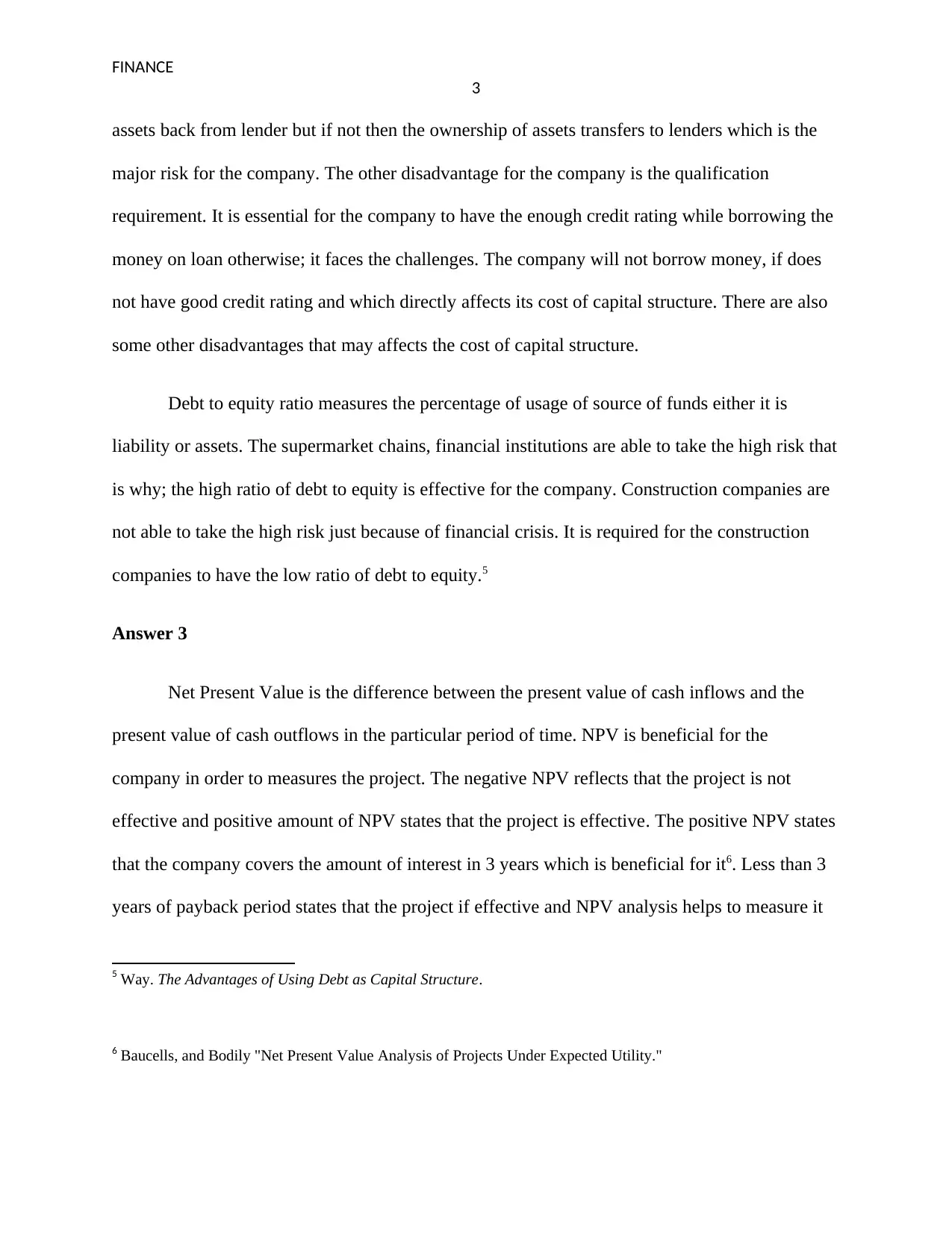
FINANCE
3
assets back from lender but if not then the ownership of assets transfers to lenders which is the
major risk for the company. The other disadvantage for the company is the qualification
requirement. It is essential for the company to have the enough credit rating while borrowing the
money on loan otherwise; it faces the challenges. The company will not borrow money, if does
not have good credit rating and which directly affects its cost of capital structure. There are also
some other disadvantages that may affects the cost of capital structure.
Debt to equity ratio measures the percentage of usage of source of funds either it is
liability or assets. The supermarket chains, financial institutions are able to take the high risk that
is why; the high ratio of debt to equity is effective for the company. Construction companies are
not able to take the high risk just because of financial crisis. It is required for the construction
companies to have the low ratio of debt to equity.5
Answer 3
Net Present Value is the difference between the present value of cash inflows and the
present value of cash outflows in the particular period of time. NPV is beneficial for the
company in order to measures the project. The negative NPV reflects that the project is not
effective and positive amount of NPV states that the project is effective. The positive NPV states
that the company covers the amount of interest in 3 years which is beneficial for it6. Less than 3
years of payback period states that the project if effective and NPV analysis helps to measure it
5 Way. The Advantages of Using Debt as Capital Structure.
6 Baucells, and Bodily "Net Present Value Analysis of Projects Under Expected Utility."
3
assets back from lender but if not then the ownership of assets transfers to lenders which is the
major risk for the company. The other disadvantage for the company is the qualification
requirement. It is essential for the company to have the enough credit rating while borrowing the
money on loan otherwise; it faces the challenges. The company will not borrow money, if does
not have good credit rating and which directly affects its cost of capital structure. There are also
some other disadvantages that may affects the cost of capital structure.
Debt to equity ratio measures the percentage of usage of source of funds either it is
liability or assets. The supermarket chains, financial institutions are able to take the high risk that
is why; the high ratio of debt to equity is effective for the company. Construction companies are
not able to take the high risk just because of financial crisis. It is required for the construction
companies to have the low ratio of debt to equity.5
Answer 3
Net Present Value is the difference between the present value of cash inflows and the
present value of cash outflows in the particular period of time. NPV is beneficial for the
company in order to measures the project. The negative NPV reflects that the project is not
effective and positive amount of NPV states that the project is effective. The positive NPV states
that the company covers the amount of interest in 3 years which is beneficial for it6. Less than 3
years of payback period states that the project if effective and NPV analysis helps to measure it
5 Way. The Advantages of Using Debt as Capital Structure.
6 Baucells, and Bodily "Net Present Value Analysis of Projects Under Expected Utility."
Paraphrase This Document
Need a fresh take? Get an instant paraphrase of this document with our AI Paraphraser
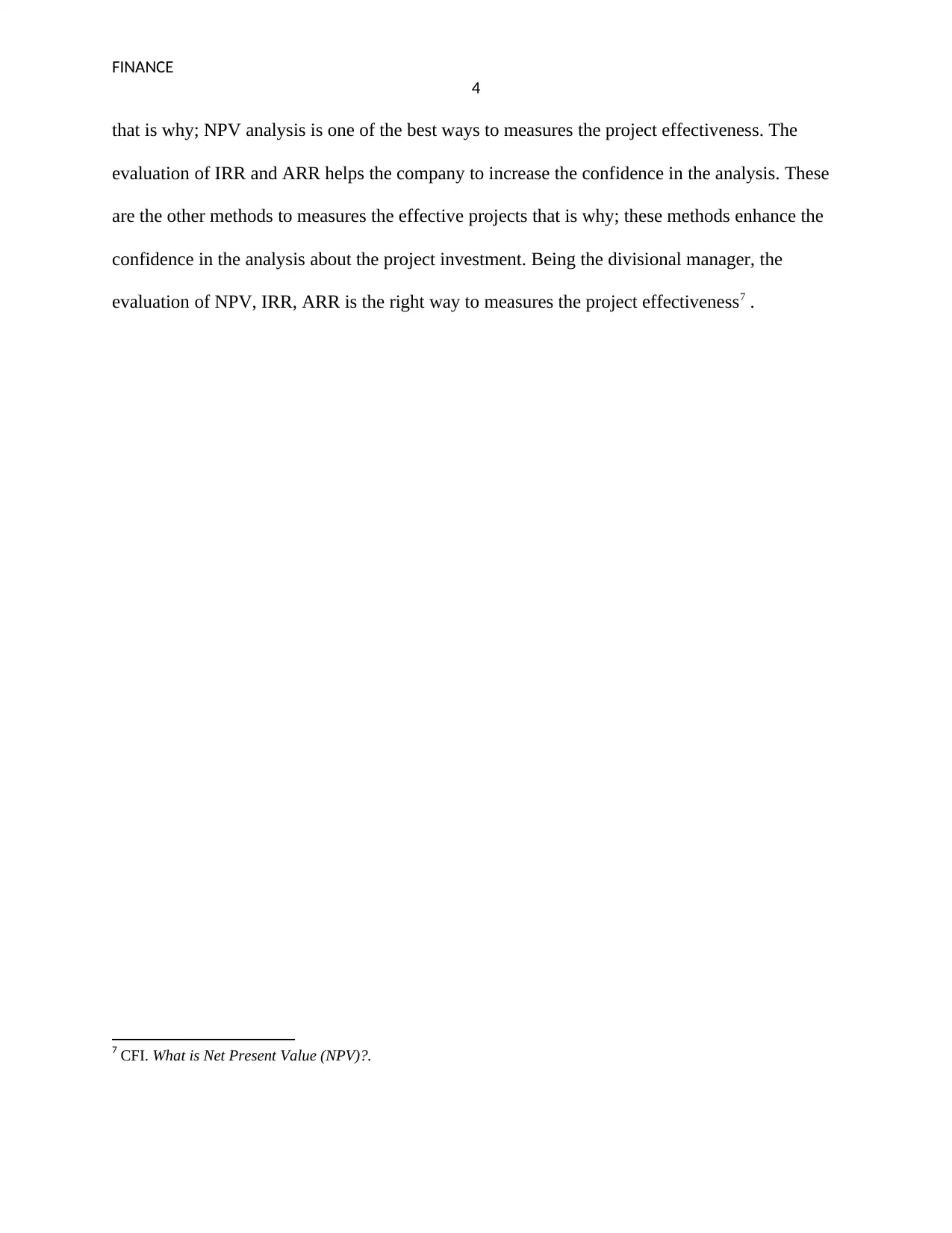
FINANCE
4
that is why; NPV analysis is one of the best ways to measures the project effectiveness. The
evaluation of IRR and ARR helps the company to increase the confidence in the analysis. These
are the other methods to measures the effective projects that is why; these methods enhance the
confidence in the analysis about the project investment. Being the divisional manager, the
evaluation of NPV, IRR, ARR is the right way to measures the project effectiveness7 .
7 CFI. What is Net Present Value (NPV)?.
4
that is why; NPV analysis is one of the best ways to measures the project effectiveness. The
evaluation of IRR and ARR helps the company to increase the confidence in the analysis. These
are the other methods to measures the effective projects that is why; these methods enhance the
confidence in the analysis about the project investment. Being the divisional manager, the
evaluation of NPV, IRR, ARR is the right way to measures the project effectiveness7 .
7 CFI. What is Net Present Value (NPV)?.
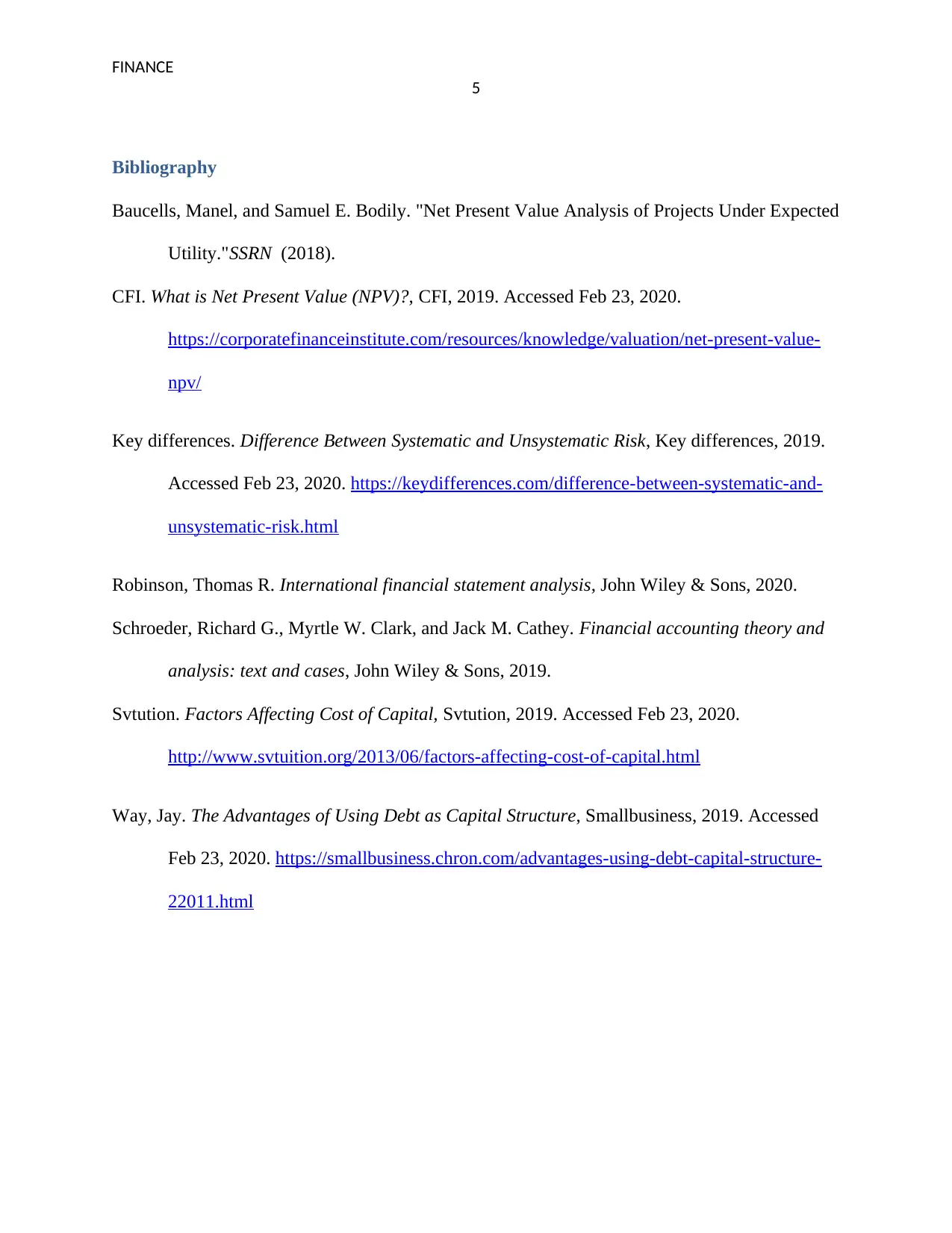
FINANCE
5
Bibliography
Baucells, Manel, and Samuel E. Bodily. "Net Present Value Analysis of Projects Under Expected
Utility."SSRN (2018).
CFI. What is Net Present Value (NPV)?, CFI, 2019. Accessed Feb 23, 2020.
https://corporatefinanceinstitute.com/resources/knowledge/valuation/net-present-value-
npv/
Key differences. Difference Between Systematic and Unsystematic Risk, Key differences, 2019.
Accessed Feb 23, 2020. https://keydifferences.com/difference-between-systematic-and-
unsystematic-risk.html
Robinson, Thomas R. International financial statement analysis, John Wiley & Sons, 2020.
Schroeder, Richard G., Myrtle W. Clark, and Jack M. Cathey. Financial accounting theory and
analysis: text and cases, John Wiley & Sons, 2019.
Svtution. Factors Affecting Cost of Capital, Svtution, 2019. Accessed Feb 23, 2020.
http://www.svtuition.org/2013/06/factors-affecting-cost-of-capital.html
Way, Jay. The Advantages of Using Debt as Capital Structure, Smallbusiness, 2019. Accessed
Feb 23, 2020. https://smallbusiness.chron.com/advantages-using-debt-capital-structure-
22011.html
5
Bibliography
Baucells, Manel, and Samuel E. Bodily. "Net Present Value Analysis of Projects Under Expected
Utility."SSRN (2018).
CFI. What is Net Present Value (NPV)?, CFI, 2019. Accessed Feb 23, 2020.
https://corporatefinanceinstitute.com/resources/knowledge/valuation/net-present-value-
npv/
Key differences. Difference Between Systematic and Unsystematic Risk, Key differences, 2019.
Accessed Feb 23, 2020. https://keydifferences.com/difference-between-systematic-and-
unsystematic-risk.html
Robinson, Thomas R. International financial statement analysis, John Wiley & Sons, 2020.
Schroeder, Richard G., Myrtle W. Clark, and Jack M. Cathey. Financial accounting theory and
analysis: text and cases, John Wiley & Sons, 2019.
Svtution. Factors Affecting Cost of Capital, Svtution, 2019. Accessed Feb 23, 2020.
http://www.svtuition.org/2013/06/factors-affecting-cost-of-capital.html
Way, Jay. The Advantages of Using Debt as Capital Structure, Smallbusiness, 2019. Accessed
Feb 23, 2020. https://smallbusiness.chron.com/advantages-using-debt-capital-structure-
22011.html
⊘ This is a preview!⊘
Do you want full access?
Subscribe today to unlock all pages.

Trusted by 1+ million students worldwide
1 out of 6
Related Documents
Your All-in-One AI-Powered Toolkit for Academic Success.
+13062052269
info@desklib.com
Available 24*7 on WhatsApp / Email
![[object Object]](/_next/static/media/star-bottom.7253800d.svg)
Unlock your academic potential
Copyright © 2020–2025 A2Z Services. All Rights Reserved. Developed and managed by ZUCOL.





